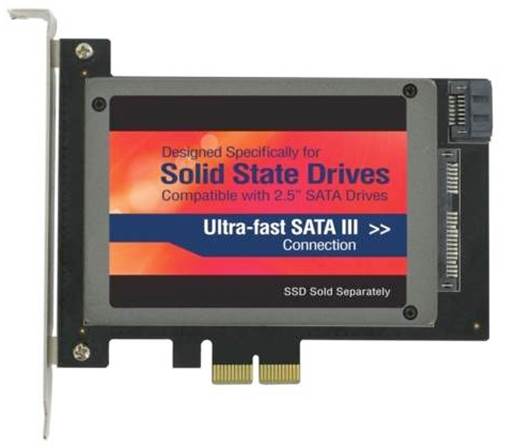The poor nerd’s RevoDrive
The Apricorn Velocity Solo X2 is designed
to do one thing and one thing only: let you upgrade your boot drive to a SATA
6Gb/s SSD on a system that doesn’t have any of them newfangled ports. Living in
a world filled with PCs that could be used in the space program, it’s not a
problem we encounter very often, but we can certainly understand its utility
where an older motherboard is involved.

Apricorn
Velocity Solo X2 PCle SSD Adapter
You will need an empty x2 (or larger) PCIe
slot to use it. However, but if you have one available and you’re not ready to
upgrade you’re motherboard, the Velocity X2 is a great solution that offers
impressive performance and an easy setup.
To use the Velocity Solo X2, simply attach
the SSD to the card itself using the provided screws. There’s a second SATA
6Gb/s port on the card that can also be plumbed to another drive and no, you
can’t run the device in RAID. With the card in your PCIe slot, you can boot the
system and the drive appears; it’s as simple as that. The board uses Marvells
newer 88SE9182 controller, an improvement over the Marvell 88SE9128 controller
found in many older motherboards.
Once we had the drive connected, we decided
to see how much performance if any we’d lose by ditching our native Intel SATA
6Gb/s ports for the Velocity Solo X2. As a x2 PCIe 2.0 compliant device, you’re
looking at a maximum theoretical bandwidth of about 1.000MB/s. For our testing,
we reached for the fastest SSO we had on hand the Samsung 840 Pro. Not
surprisingly, the drive was able to completely saturate the SATA 6Gb/s
interface’s limit.

The
board uses Marvells newer 88SE9182 controller, an improvement over the Marvell
88SE9128 controller found in many older motherboards.
In CrystalDiskMark’s sequential read and
write tests, we saw speeds of 488MB/s and 474M B, respectively. That’s only
about 20MB/s slower than what we achieved with the native InteL ports, which is
excellent. In our compressible data test in ATTO, with a 64KB write and a
four-request queue, the drive ran right up to the maximum throughput, pegging
the needle with 500MB/s write speeds and 484MB/s read speeds. In our
“real-word” PCMark Vantage test, we saw almost zero change from what we
experienced with the Samsung drive running naked on a SATA 6Gb/s port: On the
Velocity board the Samsung scored 55,272. while it racked up a score of 56,608
on an Intel port.
The one area where we saw a small loss of
performance was in heavily queued workloads. In our lometer test, which hits
the drive with a queue of 32 4K write requests at once until the drive cries
uncle, we saw performance drop by about 20,000 lOPS. This is a test we run for
people considering a certain drive for use in a web or file server, as home
users will rarely develop a 32-request queue on their desktop, but the
performance drop is notable.

it's
a PCIe 2.0 x2 lane card that is capable of delivering speeds upwards of 550MB/s
when used with a single SATA III (6GB/s) 2.5" SSD.
The final piece of the puzzle is the
included EZ Gig IV drive-cloning software, which let us easily clone our boot
drive to the Samsung SSO in just a few minutes and boot from it. It didn’t like
our USB key for some reason, but worked splendidly from a CD-R.
All in all, we give the Velocity two thumbs
up for being easy to use and offering impressive speed. We also like the second
SATA port and drive-cloning software, but we’re taking off a few points because
$100 is a bit pricey.